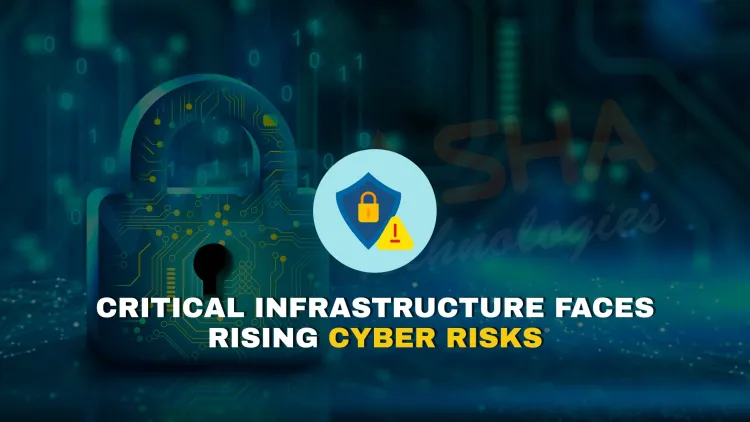What are the emerging cyber warfare threats to undersea cables and critical infrastructure in 2025?
State-sponsored cyberattacks are increasingly targeting global data infrastructure, especially submarine fiber-optic cables, smart energy grids, and IT-OT converged systems. These attacks aim to disrupt or surveil critical communication and energy flow. Threat actors use advanced techniques such as malware injection into cable landing stations, BGP route hijacking, firmware backdoors, and lateral movement from IT to OT networks. Nations like Russia, China, Iran, and North Korea have been linked to these operations. The combination of physical sabotage and digital intrusion is redefining the landscape of cyber warfare.

Table of Contents
- What Is Critical Infrastructure Cyber Warfare?
- Why Are Undersea Cables a Prime Target?
- Real-World Threats to Submarine Cable Infrastructure
- How Are Cyber Threats Exploiting Undersea Infrastructure?
- The Link Between Cyber Warfare and Energy Infrastructure
- Understanding IT/OT Convergence in Modern Cyber Warfare
- State-Sponsored Actors Behind Infrastructure Attacks
- Techniques Used in Critical Infrastructure Cyber Attacks
- How Governments and Companies Are Responding
- A Visual Overview: Cyber Attack Path on Undersea Cable & OT Systems
- Future Outlook: What’s at Stake in 2025 and Beyond?
- Conclusion
- Frequently Asked Questions (FAQs)
What Is Critical Infrastructure Cyber Warfare?
Critical infrastructure cyber warfare refers to targeted cyber operations—often conducted by nation-states—aimed at disrupting or disabling vital systems like power grids, telecommunications, water supplies, and undersea fiber optic cables. These infrastructures form the digital and physical backbone of economies and societies. In 2025, the focus has dangerously expanded to include undersea cable systems, satellite communications, and IT-OT convergence platforms, presenting new risks to global stability.
Why Are Undersea Cables a Prime Target?
Over 95% of the world’s international internet traffic moves through submarine fiber-optic cables, stretching over 1.4 million kilometers across the ocean floor. These cables are:
-
Vital for financial transactions, cloud communication, and defense coordination.
-
Privately owned but geopolitically critical.
-
Often inadequately monitored or secured.
State-backed actors like APT groups or military cyber units view them as high-value targets. Damaging or tapping into these cables can cripple economies, disrupt military operations, or result in espionage gains.
Real-World Threats to Submarine Cable Infrastructure
-
Russia’s Yantar Vessel: Known for its deep-sea capabilities and linked to suspected cable surveillance and sabotage operations.
-
2022 Faroe Islands Disruption: Two undersea cables were damaged, raising suspicions of deliberate interference.
-
Taiwan-South Pacific Cables: Increasing targeting around high-tension zones with disputed sovereignty and heavy U.S. naval presence.
These examples demonstrate how undersea cables are now becoming tools of hybrid warfare, blending kinetic, cyber, and psychological operations.
How Are Cyber Threats Exploiting Undersea Infrastructure?
Cyber attackers don’t always need to physically cut cables. They use advanced persistent threats (APTs) to exploit:
-
Shore-based landing stations
-
Network monitoring and traffic metadata
-
Data routing manipulations via BGP hijacking
-
Firmware backdoors in cable amplifiers or routers
A single breach at a cable’s terrestrial endpoint could allow adversaries to tap into data, inject malware, or reroute traffic to surveillance nodes.
The Link Between Cyber Warfare and Energy Infrastructure
Critical infrastructure includes more than just cables. Attacks are expanding into:
-
Smart energy grids
-
Natural gas pipeline SCADA systems
-
Water treatment and desalination plants
-
Nuclear plant safety systems
Cyber attackers, especially state-sponsored groups, leverage zero-day vulnerabilities or IT-OT weaknesses to disrupt industrial operations. The Ukraine power grid attacks (2015–2016) remain a chilling preview of what's possible.
Understanding IT/OT Convergence in Modern Cyber Warfare
Industrial systems are no longer isolated. IT (Information Technology) and OT (Operational Technology) now coexist in smart grids, manufacturing plants, and defense infrastructure.
This convergence creates new attack surfaces:
| IT Layer | OT Layer | Combined Risk |
|---|---|---|
| Windows servers | PLCs, SCADA, HMIs | Lateral movement across networks |
| Active Directory | Engineering workstations | Privilege escalation |
| VPN, email, remote access | Sensor control & telemetry | Ransomware entry points |
| SIEM/EDR | ICS logging/monitoring systems | Detection evasion |
When adversaries breach IT systems, they often use them to pivot into OT zones, causing physical disruptions via digital means.
State-Sponsored Actors Behind Infrastructure Attacks
Many of the most advanced threats are attributed to nation-state actors, including:
-
Russia (Sandworm, APT28) – Energy grid and cable sabotage.
-
China (APT41, Mustang Panda) – Espionage via undersea surveillance and OT control.
-
North Korea (Lazarus Group) – Disruption and financial theft targeting defense sectors.
-
Iran (Charming Kitten, APT33) – Attacks on desalination and oil infrastructure.
These actors invest in zero-day development, hardware-based implants, and satellite-based spoofing to maintain long-term access to global infrastructure.
Techniques Used in Critical Infrastructure Cyber Attacks
Some common techniques used to compromise critical systems include:
-
Firmware-level persistence in submarine amplifiers
-
Social engineering of cable station operators
-
Exploitation of OT systems through legacy VPNs
-
Data exfiltration via DNS tunneling
-
Cable traffic rerouting using BGP manipulation
-
Weaponized AI for anomaly detection bypass
How Governments and Companies Are Responding
To mitigate risks, efforts are underway globally:
-
U.S. Executive Orders to secure supply chains and industrial control systems.
-
EU’s NIS2 Directive extending protections to submarine cables and energy networks.
-
Cable Protection Zones being enforced in areas like the South China Sea and the Atlantic.
-
Public-private partnerships in threat sharing (e.g., CISA, ENISA, UK NCSC, Japan's CERT).
AI-based anomaly detection tools, red teaming for OT systems, and quantum-resilient encryption are emerging as vital defenses.
A Visual Overview: Cyber Attack Path on Undersea Cable & OT Systems
Here’s a simplified diagram of how cyberattacks unfold:
flowchart TD
A[State Actor or APT Group] --> B[Target Undersea Cable Station]
B --> C[Compromise IT System]
C --> D[Inject Malware into OT Router]
D --> E[Manipulate Traffic/Data]
C --> F[Pivot into Energy Grid]
F --> G[Disable Power Controls or Sensors]
G --> H[Critical Service Disruption]
Future Outlook: What’s at Stake in 2025 and Beyond?
-
AI-Powered Attacks: AI will assist attackers in real-time reconnaissance and adaptive malware.
-
Autonomous Cable Monitoring Drones: May be vulnerable to spoofing or hacking.
-
Quantum Threats: May render current encryption on submarine links obsolete.
-
Wartime Preparedness: Countries are preparing cyber contingency plans for undersea and energy infrastructure.
The line between physical warfare and cyber warfare is vanishing. Control of information highways like undersea cables is now equivalent to controlling airspace or oil reserves in the 20th century.
Conclusion
The cybersecurity of undersea cables and critical infrastructure is no longer just a technical issue—it's a matter of national security, economic stability, and global peace. As cyber warfare tactics become more sophisticated and geopolitical tensions rise, governments, businesses, and the cybersecurity community must act proactively to protect the backbone of the modern world.
FAQ:
What is cyber warfare targeting critical infrastructure?
Cyber warfare targeting critical infrastructure involves state-sponsored or criminal groups launching cyberattacks on essential services like power grids, communication networks, and transportation systems.
Why are undersea cables a cybersecurity concern?
Undersea cables carry global internet and communication traffic. If tampered with, they can disrupt entire nations’ access to the internet, finance systems, and military communications.
How are undersea cables attacked?
Common attack methods include malware injections at landing stations, BGP route hijacking, physical sabotage, and surveillance through cable-tapping technologies.
What role do state actors play in submarine cable attacks?
Nation-states often back operations to intercept, disrupt, or manipulate data on undersea cables for espionage, cyberwarfare, or geopolitical advantage.
Are there known cases of undersea cable cyber intrusions?
Yes. Reports have linked Russia and China to deep-sea vessel movements near strategic cables, raising concerns of potential tampering or data interception.
Can cyberattacks bring down national power grids?
Yes. Attacks on Industrial Control Systems (ICS) and SCADA can disrupt energy generation, distribution, and transmission, causing widespread blackouts.
What is IT-OT convergence in critical infrastructure?
It refers to the integration of IT (Information Technology) systems with OT (Operational Technology) systems like power plants and factory automation—creating new vulnerabilities.
What is the biggest threat from IT-OT convergence?
Once inside a network, attackers can pivot from IT systems (like email) into OT systems (like power switches), potentially halting physical operations.
What is BGP hijacking and how is it used in cyber warfare?
Border Gateway Protocol (BGP) hijacking misroutes internet traffic to rogue servers, allowing attackers to intercept or manipulate data traveling across the internet.
How does malware target submarine cable landing stations?
Attackers exploit weak authentication, outdated firmware, or insecure remote access tools to install malware in routers or terminal equipment.
What is a cable landing station?
It is a facility where undersea fiber-optic cables connect to land-based internet infrastructure. These are high-value targets in cyber operations.
Can undersea cables be tapped without being physically damaged?
Yes. Advanced adversaries can use signal-splitting techniques or install modified hardware during manufacturing or maintenance phases.
What tools are used for undersea cable surveillance?
Modified repeaters, signal processors, and specially designed submarines are known to be used for data interception and monitoring.
Is there encryption on undersea cable transmissions?
While most traffic is encrypted, metadata or routing information may still be vulnerable to interception or manipulation.
What is the role of NATO or Five Eyes in protecting cable infrastructure?
Allied nations often share intelligence and coordinate defensive efforts to monitor, secure, and respond to threats on shared infrastructure.
How are smart grids exposed to cyber threats?
Smart grids rely on interconnected networks. A vulnerability in a single device—like a smart meter—can be exploited to disrupt entire sections.
What is the role of SCADA in infrastructure attacks?
Supervisory Control and Data Acquisition (SCADA) systems manage industrial operations. If hacked, they can be manipulated to shut down or damage physical assets.
What is a hybrid cyber-physical attack?
It’s a strategy where attackers use cyber methods (malware) to cause physical damage, like overloading a power generator or disrupting pipeline pressure controls.
What are signs of a nation-state cyber attack?
Highly targeted methods, use of zero-day vulnerabilities, stealthy operations, and geopolitical alignment often point to state-sponsored involvement.
How do zero-day vulnerabilities play into infrastructure hacks?
Attackers exploit unknown software bugs (zero-days) to gain undetected access to critical systems before patches are available.
How can organizations protect cable landing stations?
Implementing strict access controls, monitoring firmware integrity, securing physical premises, and encrypting all communication channels are key steps.
How are drone and underwater technologies used in cable warfare?
Drones and unmanned underwater vehicles (UUVs) are used for surveillance, cable mapping, or even attaching malicious devices to the cable infrastructure.
Can a single undersea cable failure disrupt the internet?
Yes. While networks are redundant, key chokepoints—like those in the Suez Canal—can still lead to major slowdowns or outages.
What are chokepoints in the global cable network?
These are narrow regions like the Luzon Strait, Suez Canal, or Malacca Strait where many cables converge, making them high-risk targets.
What’s the economic impact of submarine cable attacks?
A disruption can cost millions in lost productivity, damaged trust, stock market instability, and emergency repair costs.
Are satellite communications safer than undersea cables?
While harder to intercept physically, satellite links are slower and more expensive. They’re used as backups, not replacements.
What regulations exist to protect undersea infrastructure?
Some international laws like UNCLOS regulate maritime infrastructure, but cybersecurity-specific protections are limited and nation-dependent.
How can countries respond to cable-based cyberattacks?
Through cyber diplomacy, military posturing, or launching counter-cyber operations. Attribution, however, remains a major challenge.
What is the role of AI in infrastructure cybersecurity?
AI helps monitor for anomalies, detect intrusions faster, and predict vulnerabilities in both IT and OT environments.
What industries are most vulnerable to critical infrastructure attacks?
Energy, telecom, water utilities, transportation, and healthcare are among the most frequently targeted sectors.














![Top 10 Ethical Hackers in the World [2025]](https://www.webasha.com/blog/uploads/images/202408/image_100x75_66c2f983c207b.webp)








